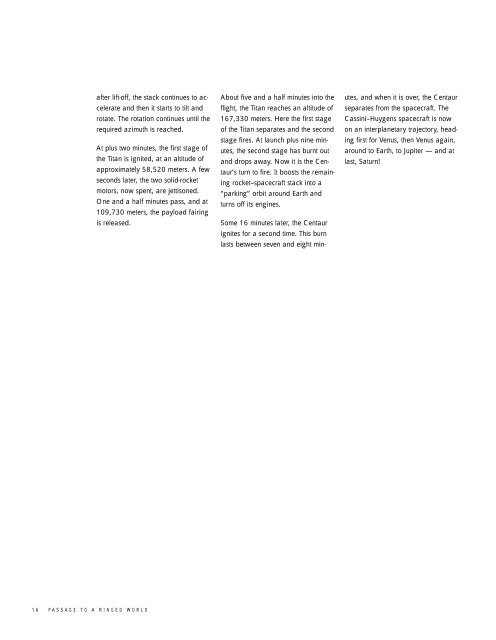Passage to a Ringed World - NASA's History Office
Passage to a Ringed World - NASA's History Office
Passage to a Ringed World - NASA's History Office
Create successful ePaper yourself
Turn your PDF publications into a flip-book with our unique Google optimized e-Paper software.
16 PASSAGE TO A RINGED WORLD<br />
after lift-off, the stack continues <strong>to</strong> accelerate<br />
and then it starts <strong>to</strong> tilt and<br />
rotate. The rotation continues until the<br />
required azimuth is reached.<br />
At plus two minutes, the first stage of<br />
the Titan is ignited, at an altitude of<br />
approximately 58,520 meters. A few<br />
seconds later, the two solid-rocket<br />
mo<strong>to</strong>rs, now spent, are jettisoned.<br />
One and a half minutes pass, and at<br />
109,730 meters, the payload fairing<br />
is released.<br />
About five and a half minutes in<strong>to</strong> the<br />
flight, the Titan reaches an altitude of<br />
167,330 meters. Here the first stage<br />
of the Titan separates and the second<br />
stage fires. At launch plus nine minutes,<br />
the second stage has burnt out<br />
and drops away. Now it is the Centaur’s<br />
turn <strong>to</strong> fire. It boosts the remaining<br />
rocket–spacecraft stack in<strong>to</strong> a<br />
“parking” orbit around Earth and<br />
turns off its engines.<br />
Some 16 minutes later, the Centaur<br />
ignites for a second time. This burn<br />
lasts between seven and eight min-<br />
utes, and when it is over, the Centaur<br />
separates from the spacecraft. The<br />
Cassini–Huygens spacecraft is now<br />
on an interplanetary trajec<strong>to</strong>ry, heading<br />
first for Venus, then Venus again,<br />
around <strong>to</strong> Earth, <strong>to</strong> Jupiter — and at<br />
last, Saturn!
















